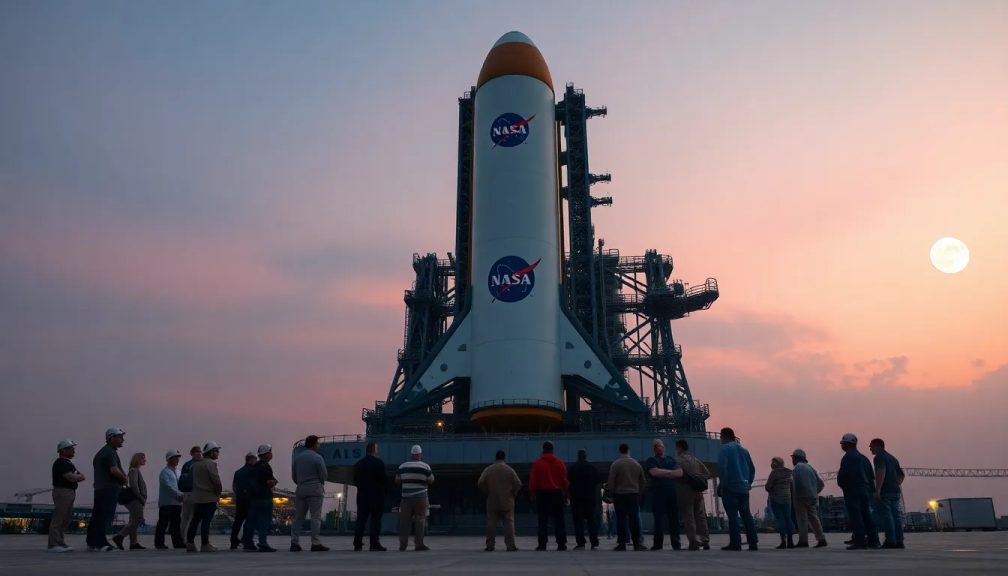NASA plans Artemis II Moon mission for early February

As humanity stands on the cusp of returning to the Moon, the excitement surrounding NASA's Artemis II mission is palpable. Scheduled for early February 2026, this mission is not just a leap for space exploration but also a historic milestone marking the first time astronauts will venture beyond low-Earth orbit in over fifty years. The implications of this mission extend far beyond mere exploration; they signal a renewed commitment to lunar research, international collaboration, and the future of human space travel.
Mission Overview: A Giant Leap for Mankind
The Artemis II mission is poised to carry four astronauts—Reid Wiseman, Victor Glover, Christina Koch, and Jeremy Hansen—on a ten-day journey that will orbit the Moon. This mission is significant as it will be the first time that humans have ventured beyond low-Earth orbit since the Apollo 17 mission in December 1972. The astronauts will not only test new systems but also gather invaluable data that will inform future lunar missions.
This mission is part of NASA's broader Artemis program, which aims to establish a sustainable human presence on the Moon by the end of the decade. The Artemis program is envisioned as a stepping stone for future missions to Mars, reinforcing NASA's commitment to deep space exploration.
Hardware Nearing Readiness
The backbone of the Artemis II mission, the Space Launch System (SLS) rocket, has been successfully stacked and is now ready for its upcoming flight. This rocket is critical for launching the Orion spacecraft, which is currently in its final stages of preparation. Soon, the Orion spacecraft will be attached to the top of the SLS, ready to embark on its historic journey.
According to Charlie Blackwell-Thompson, the Artemis launch director, the combined stack of the rocket and spacecraft will roll out to the launch site at Kennedy Space Center early next year. At the launch pad, several critical steps will follow:
- The rocket and spacecraft will connect to ground support systems.
- A "wet dress rehearsal" will be conducted, which involves fueling the rocket with liquid hydrogen and oxygen.
- The countdown will be tested down to T-29 seconds before the rocket is de-tanked and prepared for launch.
This meticulous preparation is vital for ensuring the mission's success and the safety of the astronauts on board.
Launch Window and Timeline
The launch window for Artemis II is tightly constrained by the orbits of the Earth and the Moon. Each month, there are specific windows that last between four to eight days, dictated by numerous factors such as orbital mechanics and mission requirements. For February, the launch window opens on February 5, 2026, and it is expected to occur in the evening.
Once the spacecraft is launched, it will separate from the upper stage of the SLS rocket approximately three hours after liftoff. The Orion spacecraft will then spend about 24 hours in Earth orbit, allowing the astronauts to conduct various crucial checks on the vehicle’s life support systems, thrusters, and other essential equipment.
Training and Preparations for Astronauts
As part of their preparation, the astronauts have been undergoing rigorous training to ensure they are ready for the challenges of the mission. This training includes:
- Simulations of space travel and Moon landing scenarios.
- Technical briefings on the Orion spacecraft and SLS rocket systems.
- Physical conditioning to handle the stress of launch and spaceflight.
The astronauts are also engaging in team-building exercises to ensure they can work effectively under pressure, which is essential for the success of such a high-stakes mission.
Scientific Goals and Impact
The Artemis II mission is not solely about reaching the Moon; it is also focused on gathering scientific data that will pave the way for future explorations. Some of the key scientific objectives include:
- Testing new technologies and systems for sustainability in space.
- Conducting experiments that could provide insights into the Moon's geology and potential resources.
- Establishing protocols for future missions to Mars and beyond.
This mission is expected to contribute significantly to our understanding of the Moon and its environment, which is crucial for establishing a long-term human presence in space.
International Collaboration and Future Missions
The Artemis program represents a collaborative effort among multiple countries and organizations, emphasizing the importance of international partnerships in space exploration. Various countries are contributing to the program, which enhances the mission's capabilities and broadens its reach. For instance, the European Space Agency (ESA) is providing the service module for the Orion spacecraft, showcasing how global cooperation can advance human exploration.
What’s Next After Artemis II?
The successful execution of Artemis II will set the foundation for subsequent missions, including Artemis III, which aims to land astronauts on the Moon's surface. These missions are expected to:
- Establish a sustainable lunar presence by the end of the decade.
- Conduct scientific investigations on the Moon's south pole, where water and ice resources may be found.
- Prepare for future human missions to Mars, leveraging the experience and data gained from lunar missions.
To get a better understanding of the Artemis II mission and its significance, you can watch the following video:
The Artemis II mission is a pivotal moment not only for NASA but for humanity as we continue to push the boundaries of exploration. As we prepare to send astronauts back to the Moon, the knowledge and experience gained will undoubtedly shape the future of space travel for generations to come.




Leave a Reply